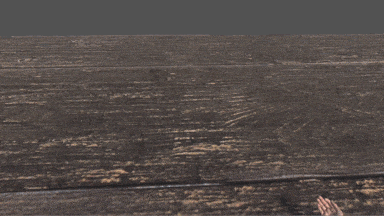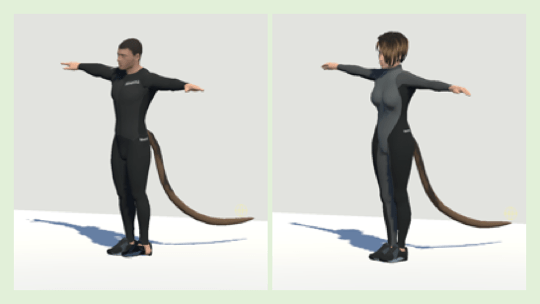

Nami OGAWA /小川 奈美
Nami OGAWA /小川 奈美
ABOUT ME

Nami Ogawa is a research scientist at CyberAgent AI Lab in Tokyo, Japan. Before joining CyberAgent, she was a principal research scientist at DMM VR lab as well as a joint researcher at Virtual Reality Educational Research Center, the University of Tokyo (Amemiya Lab). She completed her Ph.D. in Engineering at The University of Tokyo in Japan under the supervision of Michitaka Hirose, co-advised by Takuji Narumi.
Her research lies at the intersection of Virtual Reality (VR) and experimental psychology. Especially, she is interested in how the embodiment of virtual avatars affects users' experience of VR.
■ Research Interests
- Why Does Body Ownership Matter?: Effect of Self-Avatar Appearances on Perception and Behavior in VEs
- With VR, a self-avatar can be experienced as if it is one's own body, which is commonly referred to as the “Sense of Body Ownership (SoBO).” Despite a considerable body of literature recognizing the importance of SoBO in VR and elucidating the factors that influence the SoBO, little is known about how the SoBO relates to users' experiences―how they perceive and behave―in virtual environments (VEs). To answer the question “Why does the SoBO matter in VR?” my doctoral research investigates the effect of self-avatar anthropomorphism (i.e., visual human-likeness), which has been shown to affect the SoBO, on users' perceptions and behaviors in VEs.
- Related Papers:
- Effect of Self-Avatar Anthropomorphism on Perception and Behavior in Virtual Environments, 2020. (Ph.D. Thesis) [PDF] [Video] (The 2022 IEEE VGTC Virtual Reality Best Dissertation Award)
- Do You Feel Like Passing Through Walls?: Effect of Self-Avatar Appearance on Facilitating Realistic Behavior in Virtual Environments, 2020. (CHI '20) [PDF] [Video] [Video (Talk)] [DOI (Open Access)] (Honorable Mention Award)
- Effect of Avatar Appearance on Detection Thresholds for Remapped Hand Movements, 2020. (IEEE TVCG; IEEE VR '20) [PDF] [Video] [Video (Talk)] [DOI]
- Embodied Spatial Perception in VEs
- In VEs, we embody virtual bodies of different sizes and characteristics from our actual bodies. I have been questioning how this affects the way we perceive the external world in general, but particularly interested in scale perception in VEs. Specifically, I am focusing on the phenomenon that the scale of the self-body influences the scale of the world (i.e., body-based scaling). I have also been examining the difference in the scale perception between the real and virtual environments.
- Related Papers:
- Virtual Hand Realism Affects Object Size Perception in Body-Based Scaling, 2019. (IEEE VR ’19) [PDF] [Video (Talk)] [DOI]
- Distortion in perceived size and body-based scaling in virtual environments, 2017. (AH '17) [PDF] [DOI]
- Application of Experimental/Perceptual Psychology in Human-Computer Interaction
- In general, my interest lies at the intersection of experimental/perceptual psychology and HCI, including VR. Although my main expertise is in embodiment and avatars, I enjoy reaching beyond my expertise through research collaborations.
- Related Papers on Avatar Embodiment:
- Virtual Co-Embodiment: Evaluation of the Sense of Agency while Sharing the Control of a Virtual Body among Two Individuals, 2020. (IEEE TVCG; IEEE VR '21) [PDF] [Video (Short)] [Video (Long)] [Video (Talk)] [DOI]
- Do We Have to Look at the Mirror All the Time? Effect of Partial Visuomotor Feedback on Body Ownership of a Virtual Human Tail, 2019 (SAP '19) [DOI]
- Related Papers on general VR &HCI:
- Designing for Speech Practice Systems: How Do User-Controlled Voice Manipulation and Model Speakers Impact Self-Perceptions of Voice?, 2022. (CHI '22) [PDF] [Appendix] [Video] [Video (Talk)] [DOI]
- Now I’m Not Afraid: Reducing Fear of Missing Out in 360° Videos on a Head-Mounted Display Using a Panoramic Thumbnail, Proceedings of 2021 IEEE International Symposium on Mixed and Augmented Reality (ISMAR '21) [PDF] [Appendix] [Video] [Video (Talk)] [DOI]
■ Keywords
virtual reality, sense of body ownership, sense of agency, avatar embodiment, embodied perception, (self-)avatar, body-based scaling, multisensory interaction
■ Selected Papers [link]
■ Interested in collaborative research?
I'm always looking for collaborative research opportunities! Please do not hesitate in contacting me.
LATEST NEWS
- 2022.03 I received the 2022 IEEE VGTC Virtual Reality Best Dissertation Award at IEEE VR 2022. I'm so pleased and honored! [PDF]
- 2022.01 I started to work as a research scientist at CyberAgent AI Lab, Tokyo, Japan!
- 2021.11 I'll be serving as one of the Program Committee Members at Augmented Humans (AHs) 2022.
- 2021.11 Our paper entitled "Designing for Speech Practice Systems: How Do User-Controlled Voice Manipulation and Model Speakers Impact Self-Perceptions of Voice?" has been conditionally accepted to CHI 2022.
- 2021.09 Our paper entitled "Now I’m Not Afraid: Reducing Fear of Missing Out in 360° Videos on a Head-Mounted Display Using a Panoramic Thumbnail" has been accepted to ISMAR 2021. [PDF]
- 2021.03 Our position paper "Toward Understanding the Social and Societal Implications of Avatar Designs in Social VR" has been accepted to the Social VR workshop at CHI 2021.
- 2021.03 We'll present "Virtual Co-Embodiment: Evaluation of the Sense of Agency while Sharing the Control of a Virtual Body among Two Individuals" as an invited TVCG paper at IEEE VR 2021. [PDF]
- 2020.11 I'll be serving as one of the Program Committee Members at Augmented Humans (AHs) 2021.
- 2020.09 I will be serving as one of the Publicity Chairs at IEEE VR 2021.
- 2020.06 CHI 2020 was unfortunately not held, but the online presentation video of our CHI paper is out. [youtube]
- 2020.05 Our paper entitled "Virtual Co-Embodiment: Evaluation of the Sense of Agency while Sharing the Control of a Virtual Body among Two Individuals" has been accepted to IEEE TVCG [DOI].
- 2020.04 I've made a presentation of our CHI 2020 paper at Online CHI2020 - Japan Chapter local meeting.
- 2020.04 Our paper entitled "The relationship between the body and the environment in the virtual world: The interpupillary distance affects the body size perception" has been accepted to PLOS ONE. [DOI]
- 2020.03 I received Dean's Award for Dissertation Thesis.
- 2020.03 Our CHI 2020 paper has received an Honorable Mention Award.
- 2020.01 I've successfully defended my Ph.D. dissertation entitled "Effect of Self-Avatar Anthropomorphism on Perception and Behavior in Virtual Environments." [PDF]
- 2020.01 Our paper entitled "Effect of Avatar Appearance on Detection Thresholds for Remapped Hand Movements" has been accepted to IEEE TVCG [PDF]. I'll give a presentation at IEEE VR 2020.
- 2020.01 Our paper entitled "Do You Feel Like Passing Through Walls?: Effect of Self-Avatar Appearance on Facilitating Realistic Behavior in Virtual Environments" has been accepted to CHI 2020 [PDF] [Appendix] [Video]. See you in Honolulu!
PROFESSIONAL/WORK EXPERIENCE
JAN. 2022 - Present
- Research Scientist at CyberAgent AI Lab, Japan
APR. 2020 - DEC. 2021
- Principal Research Scientist at DMM VR lab, Japan
- Joint Researcher at Virtual Reality Educational Research Center, The University of Tokyo, Japan (Amemiya Lab.)
JAN. 2018 - JUN. 2018
- INRIA Rennes (France), Visiting Researcher (Hybrid Team)
Advisor: Dr. Anatole Lécuyer
OCT. 2017 - NOV. 2017
- NTT Communication Science Laboratories, Intern (Sensory Representation Research Group)
Advisor: Dr. Takahiro Kawabe
EDUCATION
APR. 2017 - MAR. 2020
- Ph.D. in Engineering, Department of Advanced Disciplinary Studies, Graduate School of Engineering, The University of Tokyo, Japan
Advisor: Prof. Michitaka Hirose (Cyber Interface Lab.)
APR. 2015 - MAR. 2017
- M.A.Sc., Graduate School of Interdisciplinary Information Studies, The University of Tokyo, Japan
Advisor: Prof. Michitaka Hirose (Cyber Interface Lab.)
APR. 2010 - MAR. 2015
- B.A., Department of Psychology, Faculty of Letters, The University of Tokyo, Japan
Advisor: Prof. Ikuya Murakami
- Ph.D. in Engineering, Department of Advanced Disciplinary Studies, Graduate School of Engineering, The University of Tokyo, Japan
RESEARCH PROJECTS
First-Authored Projects
Effect of Self-Avatar Appearance on Facilitating Realistic Behavior in VEs
By hypothesizing that a greater sense of presence would discourage users from behaving unrealistically in virtual environments (VEs), we examined how self-avatar appearances affect users’ behaviors and showed the realistic full-body self-avatar was the most effective for enhancing realistic behaviors.
Keywords: Self-Avatar, Sense of Presence, Sense of Body Ownership
- Nami Ogawa, Takuji Narumi, Hideaki Kuzuoka, and Michitaka Hirose. Do You Feel Like Passing Through Walls?: Effect of Self-Avatar Appearance on Facilitating Realistic Behavior in Virtual Environments, 2020 CHI Conference on Human Factors in Computing Systems (CHI '20), 2020. [Video] [Video (Talk)] [DOI (Open Access)] Honorable Mention Award (Top 5%), Open Access
Effect of Avatar Appearance on Detection Thresholds for Remapped Hand Movements
The study showed that realistic virtual hands (vs. abstract) can increase the detection thresholds for remapping technique wherein virtual and physical movements are in conflict; realistic avatars can make remapping less noticeable for larger mismatches.
Keywords: Self-Avatar, Sense of Body Ownership, 3DUI
- Nami Ogawa, Takuji Narumi, Michitaka Hirose: Effect of Avatar Appearance on Detection Thresholds for Remapped Hand Movements, IEEE Transactions on Visualization and Computer Graphics, 2020. [PDF] [Video] [Video (Talk)] [DOI]
Virtual Co-embodiment: Sharing the Control of a Virtual Body among Two Individuals
We introduced a concept "virtual co-embodiment", which enables a user to share their virtual avatar with another entity and described a proof-of-concept in which two users can be immersed from 1PP in a VE and can have complementary levels of control over a shared avatar. We also conducted an experiment to investigate the influence of users' level of control over the shared avatar and prior knowledge of their actions (i.e., task types) on the users' sense of agency and motor actions.
Keywords: Sense of Agency
- Rebecca Fribourg*, Nami Ogawa*, Ludovic Hoyet, Ferran Argelaguet, Takuji Narumi, Michitaka Hirose, Anatole Lécuyer: Virtual Co-Embodiment: Evaluation of the Sense of Agency while Sharing the Control of a Virtual Body among Two Individuals, IEEE Transactions on Visualization and Computer Graphics, 2020. (*: equally contributed) [PDF] [Video (Short)] [Video (Long)] [Video (Talk)] [DOI]
- Article by INRIA | Two people slipped into the same body ...virtually!
- Interactive demonstration at Altered Festival 2020
Virtual Hand Realism Affects Object Size Perception in Body-Based Scaling
Considering the theory that the scale of the external environment is perceived relative to the size of one's body, we hypothesized that self-avatar appearances affect how we perceive not only virtual bodies but also virtual spaces.
Therefore, this study examines how avatar anthropomorphism affects perceived object sizes as the size of the virtual hand changes. The results show that the size of the cube is perceived to be smaller when the virtual hand is enlarged only in the case of a realistic virtual hand.
Keywords: Self-Avatar, Sense of Body Ownership, Body-Based Scaling
- Nami Ogawa, Takuji Narumi, and Michitaka Hirose: Virtual Hand Realism Affects Object Size Perception in Body-Based Scaling, 2019. (IEEE VR ’19) [PDF] [Video (Talk)] [DOI]

Embodied Spatial Perception in VEs
VEs are often said to be compressed in terms of spatial perception. We found that size perception is distorted in a VE, and the distortion is different between virtual objects and one's own virtual hands; virtual hands are perceived as larger, whereas objects are perceived as smaller in VEs than in real environments. In addition, we showed that interaction between hands and objects affects size perception as well.
Keywords: embodied perception, body-based scaling
Co-Authored Projects
Designing for Speech Practice Systems
How Do User-Controlled Voice Manipulation and Model Speakers Impact Self-Perceptions of Voice?
We investigated the impact of user-controlled voice manipulation and listening to recordings of model speakers on self-perceptions of voice and speech.
By combining the results of quantitative and qualitative analyses, we summarized the design implications for a speech practice system.
Keywords: Voice, Speech Training, Mixed Methods, Auditory Feedback
- Lisa Orii, Nami Ogawa, Yuji Hatada, Takuji Narumi. Designing for Speech Practice Systems: How Do User-Controlled Voice Manipulation and Model Speakers Impact Self-Perceptions of Voice?, Proceedings of 2022 CHI Conference on Human Factors in Computing Systems (CHI '22) [PDF] [Appendix] [Video] [Video (Talk)] [DOI]
Reducing Fear of Missing Out in 360° Videos Using a Panoramic Thumbnail
Viewers of 360° videos often feel fear of missing out (FOMO) because they can only see a part of the video. To address this issue, we developed a technique to display thumbnails of 360° videos so that viewers can grasp the entire video when necessary. We showed that the proposed method can mitigate FOMO without compromising the sense of presence.
Keywords: 360° Video, FOMO, Sense of Presence
- Shoma Yamaguchi, Nami Ogawa, Takuji Narumi. Now I’m Not Afraid: Reducing Fear of Missing Out in 360° Videos on a Head-Mounted Display Using a Panoramic Thumbnail, Proceedings of 2021 IEEE International Symposium on Mixed and Augmented Reality (ISMAR '21) [PDF] [Appendix] [Video] [Video (Talk)] [DOI]
- Press Release (written in Japanese)

Do We Have to Look at the Mirror All the Time?
Effect of Partial Visuomotor Feedback on Body Ownership of a Virtual Human Tail.
To elicit the sense of body ownership towards virtual avatars with additional body parts, synchronous visuomotor and/or visuotactile feedback is important. So how is it possible to induce body ownership over an additional body part that one cannot directly see? We investigated the sense of body ownership in situations where only partial visual feedback is given.
Keywords: Body Ownership, Self-Avatar, Body Augmentation
- Ryota Ito, Nami Ogawa, Takuji Narumi, and Michitaka Hirose, "Do We Have to Look at the Mirror All the Time? Effect of Partial Visuomotor Feedback on Body Ownership of a Virtual Human Tail," in Proceedings of the 16th ACM Symposium on Applied Perception (SAP '19), 2019, pp. 8:1-8:9. [DOI]

Studying the Role of Self and External Touch in the Appropriation of Dysmorphic Hands
To be Updated
Keywords: Body Ownership, Self-Avatar, Body Augmentation
- Antonin Cheymol, Rebecca Fribourg, Nami Ogawa, Anatole Lécuyer, Yutaro Hirao, Takuji Narumi, Ferran Argelaguet, Jean-Marie Normand, "Studying the Role of Self and External Touch in the Appropriation of Dysmorphic Hands," in Proceedings of the 2022 IEEE International Symposium on Mixed and Augmented Reality (ISMAR '22), 2022, pp. 102-111. [PDF] [Appendix] [Video] [Video (Talk)] [DOI]
DEMONSTRATIONS
First-Authored Projects
Metamorphosis Hand
"Metamorphosis Hand" is a work that provides an experience of having an augmented body by enabling to play the piano with virtual hands whose shape, especially finger lengths, and movement are transforming dynamically.
From a psychological point of view, this system is a tool for investigating "Body Ownership", the conscious experience of the body as one's own.
I investigate how humans recognize their own bodies by causing illusion as if virtual bodies with different characteristics from their own physical bodies are as their own bodies.
From an artistic point of view, I made this work with the aim of creating new types of human-tool interaction; that is, in our long history, humans have invented tools that are fit for our constrained bodies and evolved ourselves by tool-use. Now that we can invent our bodies that are fit for the existing tools by using VR technologies, resulting in a novel human-tool coevolution.
KEYWORDS: body ownership, body augmentation
Note: There are two versions of the device, each with a corresponding video.
Nami Ogawa, Yuki Ban, Sho Sakurai, Takuji Narumi, Tomohiro Tanikawa, Michitaka Hirose: Metamorphosis Hand: Dynamically Transforming Hands, The 7th International Conference on Augmented Human (AH2016), Geneva, Switzerland, Feb, 2016. [DOI]
Swinging 3D Lamps
"Swinging 3D lamps" is a novel naked-eye 3D spatial augmented reality technology that makes a static 2D image look like 3D by adding only motion signals on it. It creates optical 3D illusions of motion parallax by superimposing luminance motion signals on a common picture in a real environment by using a projector. Our basic idea is to combine ”wiggle stereoscopy”, which is a phenomenon involving 3D perception by exploiting motion parallax with ”deformation lamps”, which is a projection technique to make static pictures dynamic.
KEYWORDS: 3D, Spatial AR, Projection, Wiggle Stereoscopy, Motion Parallax
- Nami Ogawa, Jotaro Shigeyama, Takuji Narumi, Michitaka Hirose: Swinging 3D Lamps: A Projection Technique to Create 3D Illusions on a Static 2D Image, SIGGRAPH Asia ’17 Emerging Technologies, Bangkok, Thailand, Nov. 2017. [DOI]
Polyvision
4D space has always been a source of imagination and intellectual activities for human beings. With our visualization technique based on multiple 3D projections created in VR, Polyvision equips us with the sense of 4D letting us explore high-dimensional data and mathematical objects in a totally new way.
KEYWORDS: Mathematics, 3DUI, Sensory Augumentation
- Keigo Matsumoto*, Nami Ogawa*, Hiroyuki Inou, Shizuo Kaji, Yutaka Ishii, Michitaka Hirose: Polyvision: 4D Space Manipulation through Multiple Projections, SIGGRAPH Asia '19 Emerging Technologies, Brisbane, Australia, Nov. 2019. (*: equally contributed) [DOI]
Journal Papers
- Rebecca Fribourg*, Nami Ogawa*, Ludovic Hoyet, Ferran Argelaguet, Takuji Narumi, Michitaka Hirose, Anatole Lécuyer. Virtual Co-Embodiment: Evaluation of the Sense of Agency while Sharing the Control of a Virtual Body among Two Individuals. IEEE Transactions on Visualization and Computer Graphics, vol. 27, no. 10, pp. 4023-4038, 2021. (*: equally contributed) [PDF] [Video (Short)] [Video (Long)] [Video (Talk)] [DOI]
- Nami Ogawa, Takuji Narumi, Michitaka Hirose. Effect of Avatar Appearance on Detection Thresholds for Remapped Hand Movements. IEEE Transactions on Visualization and Computer Graphics, vol. 27, no. 10, pp. 4023-4038, 2021. [PDF] [Video] [Video (Talk)] [DOI]
- Daisuke Mine, Nami Ogawa, Takuji Narumi, and Kazuhiko Yokosawa. The relationship between the body and the environment in the virtual world: The interpupillary distance affects the body size perception. PLOS ONE, 15 (4), e0232290, 2020. [DOI (Open Access)]
Peer-reviewed Conference Proceedings
- Antonin Cheymol, Rebecca Fribourg, Nami Ogawa, Anatole Lécuyer, Yutaro Hirao, Takuji Narumi, Ferran Argelaguet, Jean-Marie Normand, "Studying the Role of Self and External Touch in the Appropriation of Dysmorphic Hands," in Proceedings of the 2022 IEEE International Symposium on Mixed and Augmented Reality (ISMAR '22), 2022, pp. 102-111. [PDF] [Appendix] [Video] [Video (Talk)] [DOI] (Acceptance Rate: 21%)
- Lisa Orii, Nami Ogawa, Yuji Hatada, Takuji Narumi, "Designing for Speech Practice Systems: How Do User-Controlled Voice Manipulation and Model Speakers Impact Self-Perceptions of Voice?," in Proceedings of the 2022 CHI Conference on Human Factors in Computing Systems (CHI '22), 2022, pp. 1-14. [PDF] [Appendix] [Video] [Video (Talk)] [DOI](Acceptance Rate: 24.6%)
- Shoma Yamaguchi, Nami Ogawa, Takuji Narumi, "Now I’m Not Afraid: Reducing Fear of Missing Out in 360° Videos on a Head-Mounted Display Using a Panoramic Thumbnail," in Proceedings of the 2021 IEEE International Symposium on Mixed and Augmented Reality (ISMAR '21), 2021, pp. 176-183. [PDF] [Appendix] [Video] [Video (Talk)] [DOI] (Acceptance Rate: xx%)
- Nami Ogawa, Takuji Narumi, Hideaki Kuzuoka, and Michitaka Hirose, "Do You Feel Like Passing Through Walls?: Effect of Self-Avatar Appearance on Facilitating Realistic Behavior in Virtual Environments," in Proceedings of the 2020 CHI Conference on Human Factors in Computing Systems (CHI '20), 2020, pp. 1-14. [Video] [Video (Talk)] [DOI (Open Access)] (Acceptance Rate: 24.3%) Honorable Mention Award (Top 5%)
- Ryota Ito, Nami Ogawa, Takuji Narumi, and Michitaka Hirose, "Do We Have to Look at the Mirror All the Time? Effect of Partial Visuomotor Feedback on Body Ownership of a Virtual Human Tail," in Proceedings of the 16th ACM Symposium on Applied Perception (SAP '19), 2019, pp. 8:1-8:9. [DOI]
- Nami Ogawa, Takuji Narumi, Michitaka Hirose, "Virtual Hand Realism Affects Object Size Perception in Body-Based Scaling," in Proceedings of 2019 IEEE Conference on Virtual Reality and 3D User Interfaces (IEEE VR ’19), 2019, pp. 519-528. [PDF] [Video (Talk)] [DOI] (Acceptance Rate: 21%)
- Nami Ogawa, Takuji Narumi, and Michitaka Hirose, "Factors and Influences of Body Ownership over Virtual Hands," in Proceedings of the International Conference on Human Interface and the Management of Information, 2017, pp. 589-597. (invited)
- Nami Ogawa, Takuji Narumi, Michitaka Hirose, "Distortion in perceived size and body-based scaling in virtual environments," in Proceedings of the 8th International Conference on Augmented Human (AH'17), 2017, pp. 35:1-35:5. [PDF] [DOI]
- Shoichi Tagami, Shigeo Yoshida, Nami Ogawa, and Takuji Narumi, Tomohiro Tanikawa, Michitaka Hirose, "Routine++: Implementing Pre-Performance Routine in a Short Time with an Artificial Success Simulator", in Proceedings of the 8th International Conference on Augmented Human (AH'17), 2017, pp. 18:1-18.9.
- Sho Sakurai, Yuki Ban, Nami Ogawa, Takuji Narumi, Tomohiro Tanikawa, and Michitaka Hirose, "Diminished Agency: Attenuating a Sense of Agency for Problem Finding on Personal Physical Performance", in Proceedings of the International Conference on Human Interface and the Management of Information, 2016, pp. 487-493. (invited)
- Nami Ogawa, Yuki Ban, Sho Sakurai, Takuji Narumi, Tomohiro Tanikawa, and Michitaka Hirose, "Metamorphosis Hand: Interactive Experience of Embodying Virtually Transformed Hands", Virtual Reality International Conference (VRIC '16), 2016. (invited)
Peer-reviewed Demos
- Keigo Matsumoto*, Nami Ogawa*, Hiroyuki Inou, Shizuo Kaji, Yutaka Ishii, Michitaka Hirose, "Polyvision: 4D space manipulation through multiple projection," SIGGRAPH Asia '19 Emerging Technologies, Brisbane, Australia, Nov. 2019. (*: equally contributed)
- Nami Ogawa, Jotaro Shigeyama, Takuji Narumi, Michitaka Hirose, "Swinging 3D Lamps: A Projection Technique to Create 3D Illusions on a Static 2D Image," SIGGRAPH Asia ’17 Emerging Technologies, Bangkok, Thailand, Nov. 2017.
- Jotaro Shigeyama, Nami Ogawa, Takuji Narumi, Tomohiro Tanikawa, and Michitaka Hirose, "Presenting pseudo-haptic feedback in immersive VR environment by modifying avatar’s joint angle," IEEE World Haptics Conference 2017, Munich, Germany, Jun. 2017.
- Nami Ogawa, Yuki Ban, Sho Sakurai, Takuji Narumi, Tomohiro Tanikawa, and Michitaka Hirose, "Metamorphosis Hand: Interactive Experience of Embodying Virtually Transformed Hands," Laval Virtual ReVolution 2016, Laval, France, Mar. 2016.
- Nami Ogawa, Yuki Ban, Sho Sakurai, Takuji Narumi, Tomohiro Tanikawa, and Michitaka Hirose, "Metamorphosis Hand: Dynamically Transforming Hands," The 7th International Conference on Augmented Human (AH '16), Geneva, Switzerland, Feb. 2016.
Peer-reviewed Posters
- Daisuke Mine, Nami Ogawa, Takuji Narumi, and Kazuhiko Yokosawa, "Wider IPD Makes People Perceive Their Body to be not so Large when Large Hands are Presented," International Conference on Artificial Reality and Telexistence Eurographics Symposium on Virtual Environments (ICAT-EGVE '19 Posters), Tokyo, Japan, Sep. 2019.
- Nami Ogawa, Takuji Narumi, Michitaka Hirose, "Object Size Perception in Immersive Virtual Reality: Avatar Realism Affects the Way We Perceive," in Proceedings of the 2018 IEEE Conference on Virtual Reality and 3D User Interfaces (IEEE VR ’18 Posters), Reutlingen, Germany, Mar. 2018, pp. 647-648.
- Nami Ogawa, Takuji Narumi, Michitaka Hirose, "Swinging 3D Lamps: A Projection Technique to Convert a Static 2D Picture to 3D using Wiggle Stereoscopy," ACM SIGGRAPH ’17 Posters, Los Angeles, CA, Jul. 2017, pp. 29:1-29:2.
Invited Talks, Non-archival Papers
- Nami Ogawa, Shitao Fang, Koji Yatani, "Toward Understanding the Social and Societal Implications of Avatar Designs in Social VR," Social VR Workshop at CHI 2021, 2021. [Workshop Paper]
- Nami Ogawa, Takuji Narumi, Michitaka Hirose "Realistic Virtual Hand Fosters Self-attribution of Remapped Hand Movements," ACM Symposium on Applied Perception (SAP '19), 2019. [Poster]
Domestic Publications
Please check here
AWARDS / GRANTS
AWARDS
- MAR. 2022
The 2022 IEEE VGTC Virtual Reality Best Dissertation Award for Dissertation [PDF] - OCT. 2020
ACM UIST '20 Special Recognition for Outstanding Reviews - MAR. 2020
Dean's Award for Dissertation at Graduate School of Engineering, The University of Tokyo - Mar. 2020
Honorable Mention Award at CHI 2020 for our paper entitled "Do You Feel Like Passing Through Walls?: Effect of Self-Avatar Appearance on Facilitating Realistic Behavior in Virtual Environments" - MAR. 2018
VRSJ Young Researchers Award at the Virtual Reality Society of Japan(日本バーチャルリアリティ学会 学術奨励賞)
- MAR. 2017
Dean's Award for Master's thesis at Graduate School of Interdisciplinary Information Studies, The University of Tokyo(東京大学大学院学際情報学府 専攻長賞) - MAY. 2016
VRクリエイティブアワード2016 ファイナリスト
GRANTS
- JAN. 2018- MAY. 2018
JSPS Overseas Challenge Program for Young Researchers(日本学術振興会 平成29年度若手研究者海外挑戦プログラム)
(1.4 million Maintenance allowance + Roundtrip international airfare) - APR. 2017 - MAR. 2020
JSPS Research Fellowship DC1 (日本学術振興会 特別研究員(DC1))
(2,000 dolls monthly scholarship + around 10,000 dolls research funding for a year, selection ratios 20%) - APR. 2015 - OCT. 2016
博士課程教育リーディングプログラム ソーシャルICTグローバル・クリエイティブリーダー育成プログラム(GCL)(2016.10 辞退)
- MAR. 2022
ACADEMIC SERVICE
REVIEWER
Conferences
- IEEE VR (2019, 2020, 2021, 2022)
- Augmented Humans (2021, 2022)
- ACM CHI (2021, 2022)
- IEEE ISMAR (2021, 2022)
- ACM UIST (2020)
- ACM VRST (2018, 2020)
- ACM SAP (2019)
Journals- IEEE TVCG (2020, 2021)
- Frontiers in Psychology (2021)
- ACM TOCHI (2021)
- Journal of Information Processing (2019)
- 日本バーチャルリアリティ学会論文誌 (2018, 2019, 2022)
COMMITTEE
Program Committee
- Augmented Humans (2021, 2022)
- SIGGRAPH Asia 2021 XR Program
Conference Committee- IEEE VR 2021 Publicity Co-Chair
Domestic- 日本バーチャルリアリティ学会 ニューズレター編集委員 (2018 - 2022)
- 人工知能学会 学生編集委員 (2015 - 2017)
MISC
- 日本バーチャルリアリティ学会全国大会内OS 情報技術と文化の融合調査研究委員会(ギラギラ夏祭り) ファシリテーター(2017, 2018)
- 人工知能学会倫理委員会 書記 (2015 - 2017)
SKILLS
PROGRAMMING
Major: C# (Unity)
Minor: Python, R
LANGUAGE
Japanese: Native
English: Intermediate (TOEIC 940)
Message
Last updated: Feb 11th, 2021



